GLOBAL WARMING AND THE RAIN FOREST
rain forest in Gabon Plants, animals and bacteria and fungi in the soil all play vital roles in the carbon cycle — the circulation of carbon between air, land, water and life forms, both plant and animal. Carbon’s ability to bond with most nonmetals has made it the basis of all organic compounds found in both plants and animals.
Terrestrial vegetation uses 60 billion metric tons of carbon a year to grow, producing oxygen in the process. Carbon dioxide is soluble in water and constantly being exchanged between the air and water. To grow plants remove carbon dioxide through the air via photosynthesis to produce energy and build tissue. Respiration by bacteria and fungi that feed on organic matter returns carbon dioxide to the atmosphere. Some carbon is removed from the system and stored for as long as millions of years locked up in ocean depths or crustal rock and as coal, oil and natural gas.
The World Bank estimates that an acre of rain forest converted to crops is worth $100 to $250. It’s worth far more under a system that puts a value on carbon. An average acre stores about 200 tons of carbon; assuming a low price of $10 a ton, that acre is suddenly worth $2,000. The Amazon is often called the “earth’s lungs” for its ability to generate vast amounts of oxygen and soak up huge amounts of carbon dioxide through photosynthesis.
By some estimates deforestation and destruction of the world’s rainforests is responsible for around 17 to 20 percent of mankind’s greenhouse gas emissions — about the same as China’s or the U.S.’s emissions, and more than the emissions generated by all of the world’s cars and trucks.. [Source: Reuters]
Websites and Resources: Rainforest Action Network ran.org ; Rainforest Foundation rainforestfoundation.org ; World Rainforest Movement wrm.org.uy ; Wikipedia article Wikipedia ; Forest Peoples Programme forestpeoples.org ; Rainforest Alliance rainforest-alliance.org ; Nature Conservancy nature.org/rainforests ; National Geographic environment.nationalgeographic.com/environment/habitats/rainforest-profile ; Rainforest Photos rain-tree.com ; Rainforest Animals: Rainforest Animals rainforestanimals.net ; Mongabay.com mongabay.com ; Plants plants.usda.gov ;Books: “The Private Life of Plants: A Natural History of Plant Behavior” by David Attenborough (Princeton University Press, 1997); “Portraits of the Rainforest” by Adrian Forsythe. National Geographic articles “Rainforest Canopy, the High Frontier” by Edward O. Wilson, December 1991 ▸; “Tropical Rainforests: Nature's Dwindling Treasures”, by Peter T. White, January 1983 ∩
Could the Amazon Rainforest Becomes a Savanna
deforestation Under some extreme scenarios, large parts of the Amazon forest could turn into a savannah-like ecosystem by the middle of the 21st century with much lower levels of animal and plant biodiversity. As it stands now 6.5 million square kilometers (2.5 million square mile) forest is so huge it creates its own rainfall and is home to 10 percent of the world's species. [Source: Elizabeth Weise, USA Today, April 7, 2022]
Elizabeth Weise wrote in USA Today: In part because of the increased heat and lack of rain, the Amazon is seeing more wildfires. These destroy large areas that grow back not as rainforest but as grasslands with few trees. Illegal logging to grow grass or soybeans to feed cattle exacerbates the problem.“The recent evidence has been quite alarming. It really does look like we’re closing in on a place where a relatively modest amount of drying could kill off the rainforest and turn it into something else,” said Daniel Swain, a climate scientist at the University of California, Los Angeles.
A study published last month found signs of lost habitat in more than 75 percent of the rainforest since the early 2000s, A 2020 paper estimated as much as 40 percent of the existing rainforest might not grow back if destroyed.
Measuring Carbon Storage Capacity of Rainforests
Scientists are not sure how much carbon dioxide tropical rainforests absorb. Michael Lemonick wrote in National Geographic, “One obstacle has been the lack of a reliable way of measuring how much carbon is stored in different forests without inspecting every acre from the ground. That's where the maps shown here fit in. They were made by a team led by Gregory Asner, a tropical ecologist with the Carnegie Institution. Satellites, Asner explains, can track forest loss, but not whether it's primary forest or secondary regrowth — whether it consists of huge, old-growth trees or of scrawny saplings that store less carbon.
Asner's team can now do that by surveying the forest from a plane with lidar, a laser-ranging instrument similar to radar. The device shoots an infrared laser pulse toward the ground 100,000 times a second and records how long it takes to reflect back. Some of the light bounces off the forest canopy, but some makes it all the way to the ground. "It's kind of like an MRI," says Asner. "We can figure out not just the height of the canopy, but also the 3-D structure of the forest," and thus how much carbon it's storing. You still need on-the-ground measurements to spot-check the lidar, Asner says, and satellites to get the big picture. But all three together just might offer a way of keeping carbon trading honest — and tropical forests intact.
Effects of Global Warming on the Rainforest
In rainforests global warming could actually cause a cooling trend in the day as more clouds might be generated by a warming affect. More clouds could cause higher temperatures at night as clouds keep warm air from escaping into space. This in turn could cause more rain. In deforested areas however global warming could cause not only hotter temperature but also less precipitation as there are less trees to give off water by transpiration.
Global warming is already believed to be affecting the world’s rainforests. Studies have shown that even pristine areas untouched by deforestation, logging and other human intrusions are showing changes. One study published in Nature found that tree growth patterns during the past 20 years have been dramatically different growth patterns in previous 20-year period, with large trees in the Amazon rainforests growing more quickly and smaller trees growing more slowly. Scientist theorize that extra carbon dioxide is “fertilizing” the trees, accelerating their growth and blocking out the sun for smaller trees and other plants.
Global warming could set off a chain reaction with deforestation resulting in more carbon dioxide in the atmosphere and the increased heating causing the rainforest to dry and shrink resulting in even more carbon dioxide in the atmosphere.

greenhouse effect
Deforestation, Global Warming and Climate
Trees absorb sunlight, warming the earth but their ability to absorb carbon dioxide and generate clouds has a net cooling effect. Many environmentalists consider protecting the world’s rainforest to be a more efficient way to reduce carbon emissions than replacing coal-fired power plants. United States President Barrack Obama said in the fall of 2009, “It is probably the most cost-effective way for us to address the issue of climate change, having...mechanisms in place to avoid further deforestation.”
The annual deforestation rate of 7 million to 8 million hectares a year annually between 1990 and 2005 produced 5.8 billion tons of carbon dioxide emissions, or 17 to 20 percent of all global emissions, more than all the cars, boats and planes in the world. Calculated another way, slash-and-burn agriculture, the primary cause of rainforest deforestation, accounts for 15 percent of humanity’s carbon dioxide emissions. Indonesia and Brazil are the world’s third and forth largest carbon dioxide producers chiefly because of their high rates of deforestation.
Deforestation and the burning of the tropical rainforest contributes to global warming mainly by using up oxygen and giving off carbon dioxide during the burning process. Instead of improving the air we breath by adding oxygen it is now believed that the forest itself is neutral. The amount of oxygen trees give off during photosynthesis is roughly equal to the amount used up through the decay of organic material. The main source of carbon dioxide the greenhouse affect in the world today is the burning of the fossil fuels such as coal and oil.
The effect of deforestation on rain fall may be more alarming. It is estimated, for example, that half of the water that falls on Amazonia is generated by the forests in Amazonia. The forests gives off water as respiration. If there are no forests the water either seeps into the ground or runs of into river. The decreased surface area of the water means that less is available for evaporation.
In areas that have been cleared the humidity drops and hot winds start to rustle leaves that have never felt a breeze before. Clouds sometimes stop forming over barren tracts of land and rain patterns shift. Some deforested areas have already noted drops in rain fall, and, some believe, the process could feed on itself. Deforested and dried up wetlands release methane, a greenhouse gas more potent than carbon dioxide, into the atmosphere ∩
Global Warming and the Amazon Drought
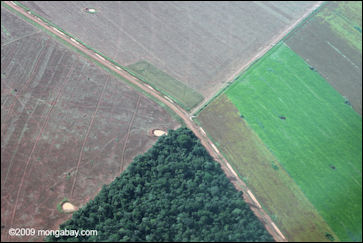
Global warming was blamed for causing once-a-century droughts in the Amazon twice in one decade. Stuart Grudgings of Reuters wrote, “A widespread drought in the Amazon rain forest in 2010 was worse than the "once-in-a-century" dry spell in 2005 and may have a bigger impact on global warming than the United States does in a year, British and Brazilian scientists said. More frequent severe droughts like those in 2005 and 2010 risk turning the world's largest rain forest from a sponge that absorbs carbon emissions into a source of the gases, accelerating global warming, the report found. [Source: Stuart Grudgings, Reuters, February 3, 2011]
Trees and other vegetation in the world's forests soak up heat-trapping carbon dioxide as they grow, helping cool the planet, but release it when they die and rot. "If events like this happen more often, the Amazon rain forest would reach a point where it shifts from being a valuable carbon sink slowing climate change to a major source of greenhouse gases that could speed it up," said lead author Simon Lewis, an ecologist at the University of Leeds. The research was a collaboration among scientists at the University of Leeds and the University of Sheffield in Britain and Brazil's Amazon Environmental Research Institute.
The study, published in the journal Science, found that the 2010 Amazon drought caused rainfall shortages over a 1.16 million square-mile (3 million square km) expanse of the forest, compared with 734,000 square miles (1.9 million square km) in the 2005 drought. It was also more intense, causing higher tree mortality and having three major epicenters, whereas the 2005 drought was mainly focused in the southwestern Amazon.
As a result, the study predicted the Amazon forest would not absorb its usual 1.5 billion metric tons of carbon dioxide from the atmosphere in both 2010 and 2011. In addition, the dead and dying trees would release 5 billion metric tons of the gas in the coming years, making a total impact of about 8 billion metric tons, according to the study. In comparison, the United States emitted 5.4 billion metric tons of carbon dioxide from fossil fuel use in 2009. The combined emissions caused by the two droughts were probably enough to have canceled out the carbon absorbed by the forest over the past 10 years, the study found.
Amazon firesThe 2010 Amazon drought dried up major rivers in the Amazon and isolated thousands of people who depend on boat transportation, shocking climate scientists who had billed the 2005 drought as a once-in-a-century event. The two intense dry spells fit predictions by some climate models that the forest will face greater weather extremes this century, with more intense droughts making it more vulnerable to fires, which in turn could damage its ability to recover.
Although human-caused deforestation in Brazil has fallen sharply in recent years, scientists say the forest is still vulnerable. The jury is still out as to whether global warming will produce more drought. A crucial question is whether the droughts are being driven by higher levels of greenhouse gases or are an anomaly, Lewis said. If they are driven by global warming, a vicious cycle of warmer temperatures and droughts could conceivably lead to a large-scale transformation of the forest over a period of decades. Prolonged drought or damaging rains could destroy crops and cause malnutrition. Scorched soil absorbs more heat and retain less water, increasing droughts.
Study Shows Forests Play a Big Role in Slowing Climate Change
David Fogarty of Reuters wrote, “The world's forests can play an even greater role in fighting climate change than previously thought, scientists say in the most comprehensive study yet on how much carbon dioxide forests absorb from the air. The study may also boost a U.N.-backed program that aims to create a global market in carbon credits from projects that protect tropical forests. If these forests are locking away more carbon than thought, such projects could become more valuable. [Source: David Fogarty, Reuters, July 11 2011]
Trees need large amounts of planet-warming carbon dioxide (CO2) to grow, locking away the carbon in the trunks and roots. But scientists have struggled to figure out exactly how much CO2 forests soak up in different parts of the world and a global total for how much is released when forests are cut down and burned. The study released in a July 2011 issue of the U.S. journal Science details for the first time the volumes of CO2 absorbed from the atmosphere by tropical, temperate and boreal forests. The researchers found that forests soak up more than 10 percent of carbon dioxide from human activities such as burning coal, even after taking into account all of the global emissions from deforestation. "This analysis puts forests at even a higher level of importance in regulating atmospheric CO2," said Pep Canadell, one of the authors and head of the Global Carbon Project based at the Commonwealth Scientific and Industrial Research Organization in Australia."If you shut them down, you're not only losing the carbon stock into the atmosphere, you're losing a very active sink which removes the carbon dioxide."
Canadell and an international research team combined data from forest inventories, models and satellites to construct a profile of forests as major regulators of atmospheric CO2. Greenhouse gas emissions from burning fossil fuels and deforestation are rising rapidly, with growth being largely driven by surging coal, oil and gas consumption in big developing nations.The researchers found that in total, established forests and young regrowth forests in the tropics soaked up nearly 15 billion tonnes of CO2, or roughly half the emissions from industry, transport and other sources.But the scientists calculated that deforestation emissions totaled 10.7 billion tonnes, underscoring that the more forests are preserved the more they can slow the pace of climate change.
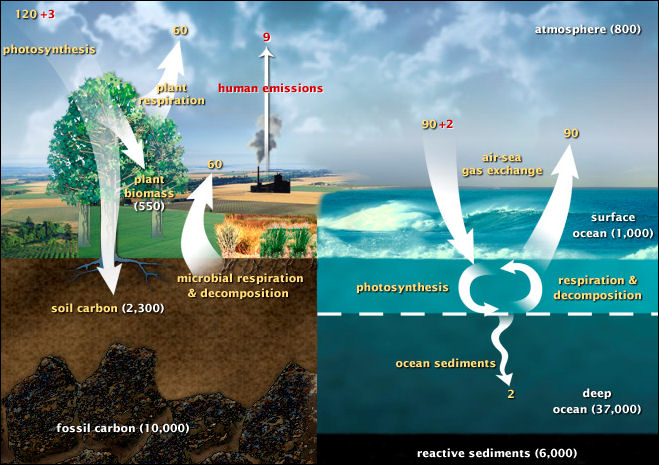
Carbon cycle
One Study Says Rainforests Absorbing Less CO2 Than Before
Simon Lewis, Aida Cuní Sanchez and Wannes Hubau wrote in The Conversation: Research we published in Nature in March 2020 “shows that intact tropical forests are removing far less carbon dioxide than they used to. The change is staggering. Across the 1990s intact tropical forests — those unaffected by logging or fires — removed roughly 46 billion tonnes of carbon dioxide from the atmosphere. This diminished to an estimated 25 billion tonnes in the 2010s. The lost sink capacity is 21 billion tonnes of carbon dioxide, equivalent to a decade of fossil fuel emissions from the UK, Germany, France and Canada combined. [Source: Simon Lewis, Professor of Global Change Science at University of Leeds and, UCL, Aida Cuní Sanchez, Postdoctoral Research Associate, University of York, and Wannes Hubau, Research Scientist, Royal Museum for Central Africa, The Conversation, March 6, 2020]
“We used a statistical model and estimates of future environmental change to estimate that by 2030 the African forests’ capacity to remove carbon will decrease by 14 percent, while Amazonian forests may stop removing carbon dioxide altogether by 2035. Scientists have long feared that one of Earth’s large carbon sinks would switch to become a source. This process has, unfortunately, begun.
“How did we reach such an alarming conclusion, and how is it that nobody knew this before? The answer is that we — along with 181 other scientists from 36 countries — have spent years tracking individual trees deep in the world’s rainforests. The idea is simple enough: we go and identify the tree species and measure the diameter and height of every individual tree in an area of forest. Then a few years later we return to exactly the same forest and re-measure all the trees again. We can see which grew, which died and if any new trees have grown. These measurements allow us to calculate how much carbon is stored in a forest, and how it changes over time. By repeating the measurements enough times and in enough places, we can reveal long-term trends in carbon uptake.
This is easier said than done.Tracking trees in tropical forests is challenging, particularly in equatorial Africa, home to the second largest expanse of tropical forest in the world. As we want to monitor forests that are not logged or affected by fire, we need to travel down the last road, to the last village, and last path, before we even start our measurements.
Another Study Says Forests Soak Up More Carbon Dioxide Than Previously Thought
Research by West Virginia University biologists led by Professor Richard Thomas and published in the "Proceedings of the National Academy of Sciences in February 2021 shows that trees around the world are consuming more carbon dioxide than previously thought. The Times West Virginian; Scientists “found that increases in carbon dioxide in the atmosphere over the past century have caused an uptick in trees' water-use efficiency, the ratio of carbon dioxide taken up by photosynthesis to the water lost by transpiration — the act of trees "breathing out" water vapor. “This study really highlights the role of forests and their ecosystems in climate change," said Thomas,"We demonstrate how forests” act “as sinks for carbon dioxide. Our research shows that forests consume large amounts of carbon dioxide globally. Without that, more carbon dioxide would go into the air and build up in the atmosphere even more than it already is, which could exacerbate climate change." [Source:Times West Virginian, February 16, 2021]
“Previously, scientists have thought that trees were using water more efficiently over the past century through reduced stomatal conductance — meaning trees were retaining more moisture when the pores on their leaves began closing slightly under rising levels of carbon dioxide. However, following an analysis using carbon and oxygen isotopes in tree rings from 1901 to 2015 from 36 tree species at 84 sites around the world, the researchers found that in 83 percent of cases, the main driver of trees' increased water efficiency was increased photosynthesis — the trees processed more carbon dioxide.
“Meanwhile, the stomatal conductance only drove increased efficiency 17 percent of the time. This reflects a major change in how trees' water efficiency has been explained in contrast to previous research. “We've shown that over the past century, photosynthesis is actually the overwhelming driver to increases in tree water use efficiency, which is a surprising result because it contradicts many earlier studies," Mathias said. "On a global scale, this will have large implications potentially for the carbon cycle if more carbon is being transferred from the atmosphere into trees."
“Since 1901, the intrinsic water use efficiency of trees worldwide has risen by approximately 40 percent in conjunction with an increase of approximately 34 percent in atmospheric carbon dioxide. Both of these characteristics increased approximately four times faster since the 1960s compared to the previous years.
“While these results show the rise in carbon dioxide is the main factor in making trees use water more efficiently, the results also vary depending on temperature, precipitation and dryness of the atmosphere. These data can help refine models used to predict the effects of climate change on global carbon and water cycles. “Having an accurate representation of these processes is critical in making sound predictions about what may happen in the future," Mathias said. "This helps us get a little closer to making those predictions less uncertain."
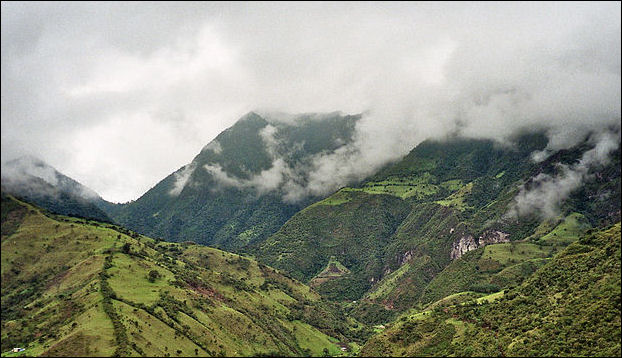
cloud forest, secondary forest and farms in Ecuador
Temperate Cool Rainforests Store More Carbon than Tropical Rainforests
Cool rainforests store more carbon per acre than tropical rainforests, according to a new book that synthesizes the work of 30 international scientists."Temperate and Boreal Rainforests of the World: Ecology and Conservation," published by Island Press, documents that in 2007 the 250 million acres of temperate and high-latitude forests stored 196 gigatons of carbon--the equivalent of six times the amount of carbon dioxide humans emit each year by burning fossil fuels. The book's editor said policymakers need to focus on "the world's forgotten rainforests." [Source: Juliet Eilperin, Washington Post, November 18, 2010]
Juliet Eilperin wrote in the Washington Post, Conservation groups and world leaders have traditionally devoted their efforts to preserving tropical forests as carbon sinks, because in addition to curbing warming they host an array of species and give developing countries a financial incentive for cutting greenhouse gas emissions.
Tropical rainforests get between 60 and 160 inches of rain a year; temperate and boreal forests receive between 40 and 100 inches of rain annually but stay much cooler, with average annual temperatures of between 43 and 52 degrees Fahrenheit. Cool rainforests are found in 10 regions of the world, including America's Pacific Northwest; inland British Columbia and parts of Idaho and Montana; Eastern Russia and Southern Siberia; and Chile and Argentina.
"In some regions, like portions of Europe, nearly all rainforests are gone while others are headed in that direction if we don't act soon," said Dominick DellaSala, chief scientist and president of the Geos Institute in Ashland, Ore. "Decades of logging has created a national ecological debt crisis that is being passed on to future generations from which we are borrowing on their biological inheritance."
These temperate and boreal forests store carbon in the massive trunks of their trees, as well as in their dense soil and foliage. Old-growth temperate forests such as some in the U.S. and Australia, DellaSalla said, store more carbon per acre than any other kind of forest in the world. Ten percent of the world's temperate forests are in the Pacific Northwest and Alaska, while another 25 percent are along the coastline of Canada's British Columbia.
America's cool rainforests are just a fraction of their historic size: between 15-20 percent of old-growth rainforests remain in the Pacific Northwest, and less than 4 percent of the region's coastal redwoods still exist.
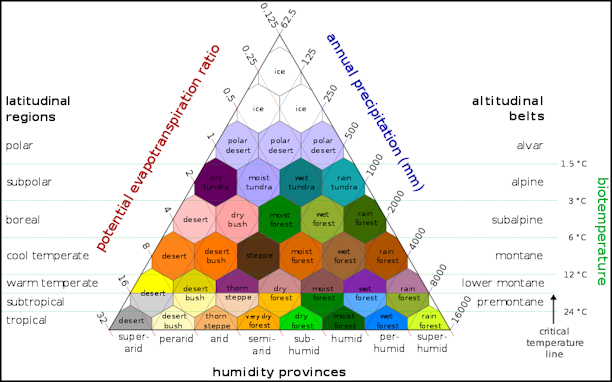
Lifezones
New Jungles and Regrowth Areas in Forests Good at Soaking Up Carbon Dioxide
Elisabeth Rosenthal wrote in the New York Times, “Globally, one-fifth of the world’s carbon emissions come from the destruction of rain forests, scientists say. It is unknown how much of that is being canceled out by forest that is in the process of regrowth in part because it is unclear how to describe or define them. The 2.1 billion acres of secondary forests includes a mishmash of land that has the potential to grow into a vibrant faux rain forest and land that may never become more than a biologically shallow tangle of trees and weeds. Regenerated forests in the tropics appear to be especially good at absorbing emissions of carbon, but that ability is based on location and rate of growth. A field abandoned in New York in 1900 will have trees shorter than those growing on a field here that was abandoned just 20 years ago. [Source: Elisabeth Rosenthal, New York Times, January 29, 2009]
David Fogarty of Reuters wrote, “A major surprise of the 2011 REDD study was the finding that young regrowth forests in the tropics were far better at soaking up carbon than thought, absorbing nearly 6 billion tonnes of CO2 -- about the annual greenhouse gas emissions of the United States."This is huge and the relevance for REDD is here you have a huge sink that is bigger than the established tropical forests," said Canadell, referring to the U.N.-backed scheme reducing emissions from deforestation and degradation. [Source: David Fogarty, Reuters, July 11 2011]
Some Forests Emitting More CO2 than They Absorb
Ten of the world’s most treasured forests and nature reserves, including those in Yosemite National Park in the United States and Sumatra’s tropical rainforest in Indonesia, have emitted more carbon dioxide than they have absorbed in recent years and have gone from being net consumers of heat-trapping carbon dioxide in the atmosphere to net generators of it. The U.N.-backed study by the Switzerland-based International Union for Conservation of Nature and UNESCO cited factors like logging, wildfires and clearance of land for agriculture. Fortunately, the excess carbon turns up at just 10 of 257 forests classified among UNESCO World Heritage sites.[Source: Jamey Keaten, Associated Press, October 28, 2021]
The study was based on information collected through on-site monitoring and from satellites. “All forests should be assets in the fight against climate change,” said Tales Carvalho Resende, a co-author of the report who works at Paris-based UNESCO. “Our report’s finding that even some of the most iconic and best protected forests, such as those found in World Heritage sites, can actually contribute to climate change is alarming.”
“The 10 sites that were net sources of carbon from 2001 to 2020 were the Tropical Rainforest in Sumatra; the Río Platano Biosphere Reserve in Honduras; Grand Canyon National Park and Yosemite National Park in the United States: Waterton Glacier International Peace Park in Canada and the U.S.; the Barberton Makhonjwa Mountains in South Africa; Kinabalu Park in Malaysia; the Uvs Nuur Basin in Russia and Mongolia; the Greater Blue Mountains area of Australia; and Morne Trois Pitons National Park in Dominica.
Associated Press reported: “All told, however, the net carbon emissions from the 10 sites together amount to little compared to the total of roughly 190 million tons of carbon dioxide that are absorbed each year by all 257 UNESCO-listed forests. Of those, about 80 sites were net neutral, while the rest were net absorbers of carbon.The 10 sites accounted for nearly 5.5 million tons of net carbon emissions. The most impactful was the Tropical Rainforest in Sumatra, which removed about 1.2 million tons from the atmosphere, but released another 4.2 million — making for net emissions of about 3 million tons. That was from a combination of logging and wood harvesting, as well as the impact of agriculture, the study found.In the United States, Yosemite generated a net of approximately 700,000 tons of carbon, largely due to a bout of devastating wildfires in the area in recent years. Tales Carvalho Resende pointed to four “really huge wildfires” over the last decade at World Heritage sites.
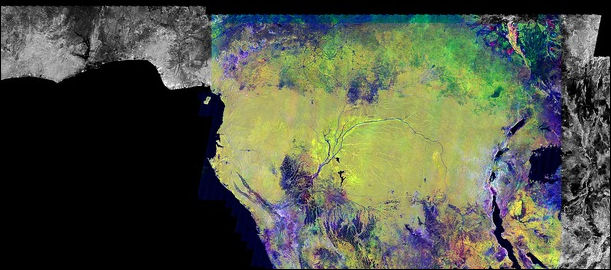
satellite image of the Congo basin
Reducing Emissions from Deforestation and Forest Degradation (REDD)
In recent years here has been a lot of discussion of rewarding countries for preserving existing forests and reducing rates of deforestation and punishing those who don’t do more to reduce carbon emissions but coming up with a system that is fair and verifiable is elusive. For example, you can reward countries like Indonesia and Brazil for reducing their deforestation rate but what about countries like Guyana and Suriname that have maintained high forest cover.
Leaders of poor tropical countries have argued that the cheapest way to combat not only deforestation but also global warming is for rich, developed countries to pay poor, tropical developing countries not to fell trees. The governors of several Amazon states have signed agreements with California to sell carbon credits in California’s cap-and-trade market that would allow California businesses to meet their emission targets by donating money for rainforest protection.
Under the Reducing Emissions from Deforestation and Forest Degradation (REDD) programs approved at the climate change summit in Copenhagen governments of industrial nations such as the United States will auction emission allowances and the money raised (as much as $3 billion) will go into rainforest protection.
Under the REDD agreement contributors pay about $6.59 for each ton of carbon dioxide they save by reducing deforestation. In contrast, fitting carbon capture and storage systems on a coal-fired plants cost $82 for each ton saved. The first test of these system was an agreement in which Norway will pay Guyana $247 million for preserve trees with payments made on condition that Guyana prove is holding up its end of the bargain and not wasting the money on corruption. Norway also has a deal with Indonesia to pay it $1 billion for preserving its forests and peat lands.
In conjunction with REDD Google UK has released satellite images of rainforest areas on the Internet, allowing anyone with Internet access to compare images of the same places at different times to monitor deforestation and make sure countries involved with the REDD agreement and keeping their promises. Philipp Schidler of Google UK told the Times of London, “Our engineers are exploring how we might contribute to this effort by developing a global forest platform that would enable anyone in the world, including tropical nations to monitor deforestation and draw attention to it.”
Letting Forest Regrow Naturally — an Effective, Low-Cost Way to Slow Climate Change
A group of professors wrote in The Conversation:“Many organizations and communities are working to restore native forests by reclaiming unproductive or abandoned land and carrying out costly tree-planting efforts. These efforts are designed to encourage the return of native plants and animals and to recover the ecological functions and goods that those forests once provided. But in many cases forests can recover naturally, with little or no human assistance. [Source: Robin Chazdon, Professor Emerita of Ecology and Evolutionary Biology, University of Connecticut, Catarina Conte Jakovac, Associate professor of Plant Science, Universidade Federal de Santa Catarina, Lourens Poorter, Professor of Functional Ecology, Wageningen University, The Conversation, and Bruno Hérault, Tropical Forest Scientist, Forests & Societies Research Unit, Cirad, The Conversation December 10, 2021]
“Most forests around the world today have regrown after human and natural disturbances, including fires, floods, logging and clearance for agriculture. For example, forests recovered in Europe during the 18th and 19th centuries and in the eastern U.S. from the early to mid-20th century. Today the northeastern U.S. has more forest cover than it did 100 to 200 years ago.
Scientists and policymakers widely agree that it is critical to protect these regrowing forests and prevent more destruction and conversion of old-growth forests. Our findings show that tropical forest regrowth is an effective and low-cost, nature-based strategy for promoting sustainable development, restoring ecosystems, slowing climate change and protecting biodiversity. And since regrown forests in areas where the land has not been heavily damaged quickly recover many of their key attributes, forest recovery doesn’t always require planting trees. In our view, a range of suitable reforestation methods can be implemented, depending on local site conditions and local people’s needs. We recommend relying on natural regrowth wherever and whenever possible, and using active restoration planting when needed.
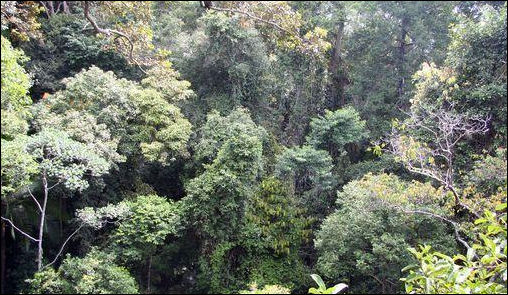
Image Sources: Wikimedia Commons; Mongabey
Text Sources: World Meteorological Organization; National Oceanic and Atmospheric Administration (NOAA), New York Times, Washington Post, Los Angeles Times, Times of London, Yomiuri Shimbun, The Guardian, National Geographic, The New Yorker, Time, Newsweek, Reuters, AP, Lonely Planet Guides, Compton’s Encyclopedia and various books and other publications.
Last updated April 2022



